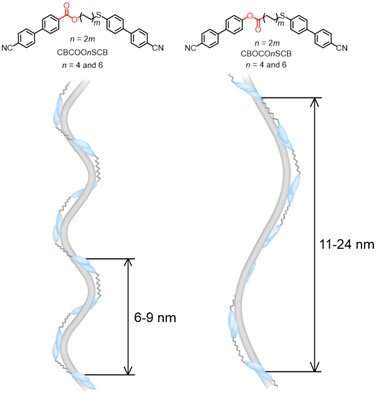Credit: Unsplash/CC0 Public Domain
A team of researchers led by Assistant Professor Yuki Arakawa (Toyohashi University of Technology, Japan) has successfully developed sulfur-containing liquid crystal (LC) dimer molecules) with oppositely directed ester bonds, which exhibit a helical liquid crystal phase, viz. twist-bend nematic (NTB) phase) over a wide temperature range, including room temperature. Collaboration with a team at the Advanced Light Source research facility (Lawrence Berkeley National Laboratory, USA) revealed that the ester bond direction in the molecular structures largely impacts the pitch lengths of helical nanostructures in the NTB phase. It is expected that this molecular design can be used to tune the resultant physical properties of LC materials that would contribute to new LC technologies, such as LC laser, photo-alignment, and display technologies.
The NTB is a newly identified fluidic LC phase, which possesses a helical nanostructure with a pitch ranging from several to tens of nanometers, becoming a hot topic in the LC science community. Recently, various approaches were explored to apply the NTB materials to wavelength-tunable LC laser and photo-alignment technologies. In terms of practicality, LC materials must be devised by forming LC phases over a broad temperature range and at room temperature. However, molecules that exhibit the NTB phase over a wide temperature range, including room temperature, remain exceptionally rare. This has impeded deep evaluations of various properties and the development of new applications.
Assistant Professor Yuki Arakawa and his team in the Toyohashi University of Technology have been taking interest in developing novel sulfur-containing LC materials, especially for high-birefringence materials and twist-bend nematic LCs, based on thioether (R-S-R) linkages that contain sulfur, which is a component of hot springs and one of the few surplus resources in Japan. Sulfur or thioether bonds have high polarizability and are expected to be useful functional moieties for improving physical properties, such as refractive index and birefringence, compared with other bonds based on conventional atoms, such as methylene (carbon) and ether (oxygen).
Molecular structures of the synthesized LC dimers and images of the resultant helical nanostructures with different helical pitches. Reproduced from the reference. Credit: TOYOHASHI UNIVERSITY OF TECHNOLOGY.
Previously, Assistant Professor Yuki Arakawa and his team had successfully developed thioether-based bent molecules that exhibit the NTB phase. In this study, we attempted to devise new LC dimers by introducing oppositely directed ester bonds (i.e., -C=OO- and -O=CO-) to the thioether-based bent dimeric molecules and elucidate the influence of the ester bond direction on the NTB phase behaviors. The team succeeded in developing new molecules that exhibit NTB phases over a wide temperature range, including room temperature.
Furthermore, the team observed a phenomenon, in which the helical pitches (6-9 nm) of the molecules with O=CO ester were approximately double (11-24 nm) of those with C=OO ester (Figure 1). This is because the C=OO-ester dimers have more bent molecular geometries than the O=CO-ester dimers, resulting in enhanced molecular precession in the helical structure for the former than for the latter. Finely tuning the molecular design (i.e., the ester bond direction) enables the manipulation of helical nanostructures, which is particularly important for optical applications.
According to Assistant Professor Arakawa, "LC molecules that exhibit the helical NTB phase over a broad temperature range, including room temperature, remain rare. No studies have clearly revealed the structure-property relationship between molecular design and the resultant helical structure, i.e. how the helical nano-structures can be controlled by molecular design. We believe that our studies provide insight into it."
More information: Yuki Arakawa et al, Distinct twist-bend nematic phase behaviors associated with the ester-linkage direction of thioether-linked liquid crystal dimers, Materials Advances (2020). DOI: 10.1039/D0MA00746C
Provided by Toyohashi University of Technology

























